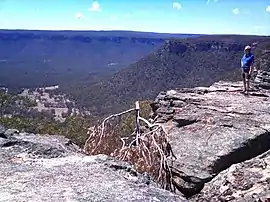| Gardens of Stone National Park New South Wales | |
|---|---|
 A view of the natural stone pagodas in the national park | |
 Gardens of Stone National Park | |
| Nearest town or city | Lithgow |
| Coordinates | 33°9′16.6″S 150°2′27.5″E / 33.154611°S 150.040972°E |
| Established | 30 November 1994[1] |
| Area | 150.8 km2 (58.2 sq mi)[1] |
| Managing authorities | NSW National Parks & Wildlife Service |
| Website | Gardens of Stone National Park |
| See also | Protected areas of New South Wales |
The Gardens of Stone National Park is a protected national park that is located in the Central Tablelands region of New South Wales in eastern Australia. The 15,080-hectare (37,300-acre) national park is situated 125 kilometres (78 mi) northwest of Sydney, and 30 kilometres (19 mi) northwest of Lithgow. The national park draws its name from the natural stone pagodas within its boundaries.[2]
The Gardens of Stone National Park is one of the eight protected areas that, in 2000, was inscribed to form part of the UNESCO World Heritage–listed Greater Blue Mountains Area.[3] The national park forms part of the Great Dividing Range.
Features and location
The most prominent features of the park are the sandstone pagoda landscapes and cliffs and canyons.[4] Limestone outcrops, karsts and elevated swamps are other unusual features.[2]
The park is bounded on the west by the Castlereagh Highway; to the north by the Glen Davis Road; to the east by the Wollemi National Park; and to the south by the Newnes State Forest, the Wolgan Valley, and the Wolgan State Forest. The rural localities of Capertee, Ben Bullen, and Glen Davis are located on the edge of the national park.
History
The Newnes Plateau region was proposed for conservation in 1932 as part of a Greater Blue Mountains National Park by the National Parks and Primitive Areas Council.[2] Lobbying for protecting the area increased after the establishment of Wollemi National Park in 1979.[5] The National Parks Association proposed its extension westwards in 1984, which developed into a detailed proposal of an 18,030-hectare (44,600-acre) park in 1993, which was ultimately successful.[2] The Gardens of Stone National Park was established in 1994;[5] however, the initial park only covered 11,780 hectares (29,100 acres), omitting areas which contain coal deposits. It was later enlarged to 15,080 hectares (37,300 acres).[6] Environmentalist groups seek to protect more of the surrounding area, which includes pagodas, canyons, heathland and elevated swamps.[5]
Flora and fauna
A total of 423 native plant species have been recorded in the park in 30 different plant communities. Most of the park is covered in open forest or woodland dominated by eucalypts. In the west of the park, there are ironbark (Eucalyptus fibrosa and E. crebra) and yellow box (Eucalyptus melliodora) woodlands that grow on clay loam and are a habitat for the rare regent honeyeater and turquoise parrot. There is white box (Eucalyptus albens) woodland in the southwest and scribbly gum (Eucalyptus rossii and E. sparsifolia) woodland on the park's eastern borders.[2]
The plant and animal communities of the pagoda formations are fragile and easily irreversibly damaged by human activity. Collection of bush rocks for gardens and landscaping removes habitat for reptiles.[2]
See also
References
- 1 2 "Gardens of Stone National Park: Park management". Office of Environment & Heritage. Government of New South Wales. Retrieved 8 October 2014.
- 1 2 3 4 5 6 "Gardens of Stone National Park: Plan of Management" (PDF). NSW National Parks & Wildlife Service (PDF). Government of New South Wales. June 2009. ISBN 978-1-74232-384-8.
- ↑ "Greater Blue Mountains Area". World Heritage List. UNESCO. 2014. Retrieved 8 October 2014.
- ↑ "Gardens of Stone National Park: Plants, animals and landscape". Office of Environment & Heritage. Government of New South Wales. 26 March 2013. Retrieved 5 June 2013.
- 1 2 3 Blue Mountains Conservation Society (2011). "Gardens of Stone National Park". Greater Blue Mountains World Heritage Experience. NSW National Parks & Wildlife Service. Retrieved 4 June 2013.
- ↑ Washington, Haydn G.; Wray, Robert A. L. (2011). "The Geoheritage and Geomorphology of the Sandstone Pagodas of the North-western Blue Mountains Region (NSW)" (PDF). Proceedings of the Linnean Society of New South Wales (PDF). 132: 131–43. ISSN 0370-047X. Archived (PDF) from the original on 13 October 2014.
External links
- "Gardens of Stone National Park". NSW National Parks & Wildlife Service. Government of New South Wales.
- "Gardens of Stone National Park: Plan of Management" (PDF). NSW National Parks & Wildlife Service (PDF). Government of New South Wales. June 2009. ISBN 978-1-74232-384-8.
- "Greater Blue Mountains World Heritage Area: Strategic Plan" (PDF). NSW National Parks and Wildlife Service (PDF). Government of New South Wales. January 2009. ISBN 978-1-74122-960-8. Archived (PDF) from the original on 15 June 2009.
- "Gardens of Stone National Park". Office of Environment & Heritage. Government of New South Wales.
- Dingo Gap photos of GOS NP
.jpg.webp)